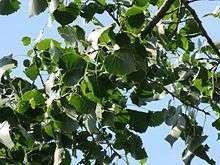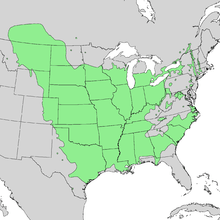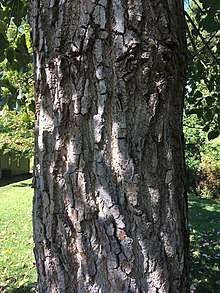Populus deltoides
| Eastern cottonwood | |
|---|---|
 | |
| Foliage | |
| Scientific classification | |
| Kingdom: | Plantae |
| Clade: | Angiosperms |
| Clade: | Eudicots |
| Clade: | Rosids |
| Order: | Malpighiales |
| Family: | Salicaceae |
| Genus: | Populus |
| Section: | Populus sect. Aigeiros |
| Species: | P. deltoides |
| Binomial name | |
| Populus deltoides | |
 | |
| Native range | |
Populus deltoides, the eastern cottonwood[1] or necklace poplar,[2] is a cottonwood poplar native to North America, growing throughout the eastern, central, and southwestern United States, the southernmost part of eastern Canada, and northeastern Mexico.[3]
Description
Populus deltoides is a large tree growing to 20–40 m (65–130 ft) tall and with a trunk up to 1.8 m (5 ft 11 in) diameter, one of the largest North American hardwood trees. The bark is silvery-white, smooth or lightly fissured when young, becoming dark gray and deeply fissured on old trees.
The twigs are grayish-yellow and stout, with large triangular leaf scars. The winter buds are slender, pointed, 1–2 centimetres (1⁄2–3⁄4 in) long, yellowish brown, and resinous. It is one of the fastest growing trees in North America. In Mississippi River bottoms, height growth of 10–15 feet (3–5 m) per year for a few years have been seen. Sustained height growth of 5-foot (1.5-meter) height growth and 1-inch (2.5-centimeter) diameter growth per year for 25 years is common.
The leaves are large, deltoid (triangular), 4–10 cm (1 1⁄2–4 in) long and 4–11 cm (1 1⁄2–4 1⁄4 in) broad with a truncated (flattened) base and a petiole 3–12 cm (1 1⁄4–4 3⁄4 in) long. The leaf is very coarsely toothed, the teeth are curved and gland tipped, and the petiole is flat; they are dark green in the summer and turn yellow in the fall (but many cottonwoods in dry locations drop their leaves early from the combination of drought and leaf rust, making their fall color dull or absent). Due to the flat stem of the leaf, the leaf has the tendency to shake from even the slightest breeze. This is one of the identifying characteristics.[4]
It is dioecious, with the flowers (catkins) produced on single-sex trees in early spring. The male (pollen) catkins are reddish-purple and 8–10 cm (3 1⁄4–4 in) long; the female catkins are green, 7–13 cm (2 3⁄4–5 in) long at pollination, maturing 15–20 cm (6–7 3⁄4 in) long with several 6-to-15-millimeter (1⁄4-to-9⁄16-inch) seed capsules in early summer, which split open to release the numerous small seeds attached to cotton-like strands.[5][6][7]
Variation
The species is divided into three subspecies[3][8] or up to five varieties.[9] The subspecies classification is as follows:
- Populus deltoides subsp. deltoides, eastern cottonwood is found in southeastern Canada (the south of Ontario and Quebec) and the eastern United States (throughout, west to North Dakota to Texas).
- P. d. monilifera (Aiton) Eckenw., the plains cottonwood (syn. P. deltoides var. occidentalis Rydb.; P. sargentii Dode) ranges from southcentral Canada (southern Alberta, Saskatchewan, and Manitoba) to the central United States and south to northern New Mexico and Texas.
- P. d. wislizeni (S.Watson) Eckenw., the Rio Grande cottonwood (syn. P. wislizeni (S.Watson) Sarg.; P. fremontii var. wislizeni S.Watson) grows from southern Colorado south through Texas to northeastern Mexico (Chihuahua, San Luis Potosi), and west to Arizona (presence in California, listed by GRIN,[3] is doubtful, not included in the Jepson Flora of California[10]). (Note: Some sources mistakenly spell the epithet "wislizenii." Correct spelling is with one "i," per ICN article 60C.2.[11])
Ecology
It needs bare soil and full sun for successful germination and establishment; in natural conditions, it usually grows near rivers, with mud banks left after floods providing ideal conditions for seedling germination; human soil cultivation has allowed it to increase its range away from such habitats.[7]
The leaves serve as food for caterpillars of various Lepidoptera (List of Lepidoptera that feed on poplars).
Oldest and largest

Eastern cottonwoods typically live 70 to 100 years, but they have the potential to live 200 to 400 years if they have a good growing environment.
The Balmville Tree (cut in 2015) was the oldest eastern cottonwood in the United States.
- The US national champion Populus deltoides var. deltoides is located in Beatrice, Nebraska and measures 88 ft (27 m) tall, 108 ft (33 m) wide.[12]
- The US national champion Populus deltoides var. monilifera is located in Ravalli County, Montana and measures 112 ft (34 m) tall, 94 ft (29 m) wide.[13]
- The US national champion Populus deltoides var. wislizeni is located in Bernalillo County, New Mexico and measures 84 ft (26 m) tall, 83 ft (25 m) wide.[14]
The largest recorded cottonwood tree in the world is the Frimley Park tree located in Hastings, New Zealand and measures 138 ft (42 m) tall, 111 ft (34 m) wide and 33.4 ft (10.2 m) in girth.[15] This Cottonwood was planted in the 1870's.
Symbolism
Calling the cottonwood tree "the pioneer of the prairie", the Kansas state legislature designated the cottonwood the official state tree of Kansas in 1937.[16]
See also
References
- ↑ "Populus deltoides". Natural Resources Conservation Service PLANTS Database. USDA. Retrieved 31 January 2016.
- ↑ "BSBI List 2007". Botanical Society of Britain and Ireland. Archived from the original (xls) on 2015-01-25. Retrieved 2014-10-17.
- 1 2 3 "Populus deltoides". Germplasm Resources Information Network (GRIN). Agricultural Research Service (ARS), United States Department of Agriculture (USDA).
- ↑ Barnes and Wagner, Michigan Trees, University of Michigan Press, 2004
- ↑ USGS Aquatic and Wetland Vascular Plants of the Northern Great Plains: A successful, simple, reproducible, high frequency micropropagation protocol has been described by Yadav Rakesh et al., 2009 Populus deltoides Archived 2007-12-23 at the Wayback Machine.
- ↑ v-Plants (Chicago Herbarium): Populus deltoides Archived 2007-08-13 at the Wayback Machine.
- 1 2 Van Haverbeke, David F. (1990). "Populus deltoides". In Burns, Russell M.; Honkala, Barbara H. Hardwoods. Silvics of North America. Washington, D.C.: United States Forest Service (USFS), United States Department of Agriculture (USDA). 2 – via Southern Research Station (www.srs.fs.fed.us).
- ↑ Eckenwalder, J.E. (1977). "North American cottonwoods (Populus, Salicaceae) of sections Abaso and Aigeiros". Journal of the Arnold Arboretum. 58 (3): 193–208.
- ↑ The Plant List: A working list of all plant species, Royal Botanic Gardens, Kew and Missouri Botanical Garden
- ↑ Jepson Flora: Populus; clicking 'next taxon' through the genus shows no entry for this taxon)
- ↑ J. McMeill et al. (eds). 2012. International Code of Nomenclature for algae, fungi, and plants. Regnum Vegetabile 154. Koeltz Scientific Books. ISBN 978-3-87429-425-6
- ↑ American Forests (2013). "Eastern Cottonwood (Populus deltoides ssp. deltoides)". Retrieved July 14, 2016.
- ↑ American Forests (2012). "Plains Cottonwood (Populus deltoides ssp. monilifera)". Retrieved July 14, 2016.
- ↑ American Forests (2012). "Rio grande Cottonwood (Populus deltoides ssp. wislizeni)". Retrieved July 14, 2016.
- ↑ "Tree Information". The Zealand Tree Register. Retrieved 18 April 2018.
- ↑ "Tidbits". Ludington Daily News. Aug 4, 2001. p. 33. Retrieved 15 October 2015.
External links

- Video footage of Eastern Cottonwood
